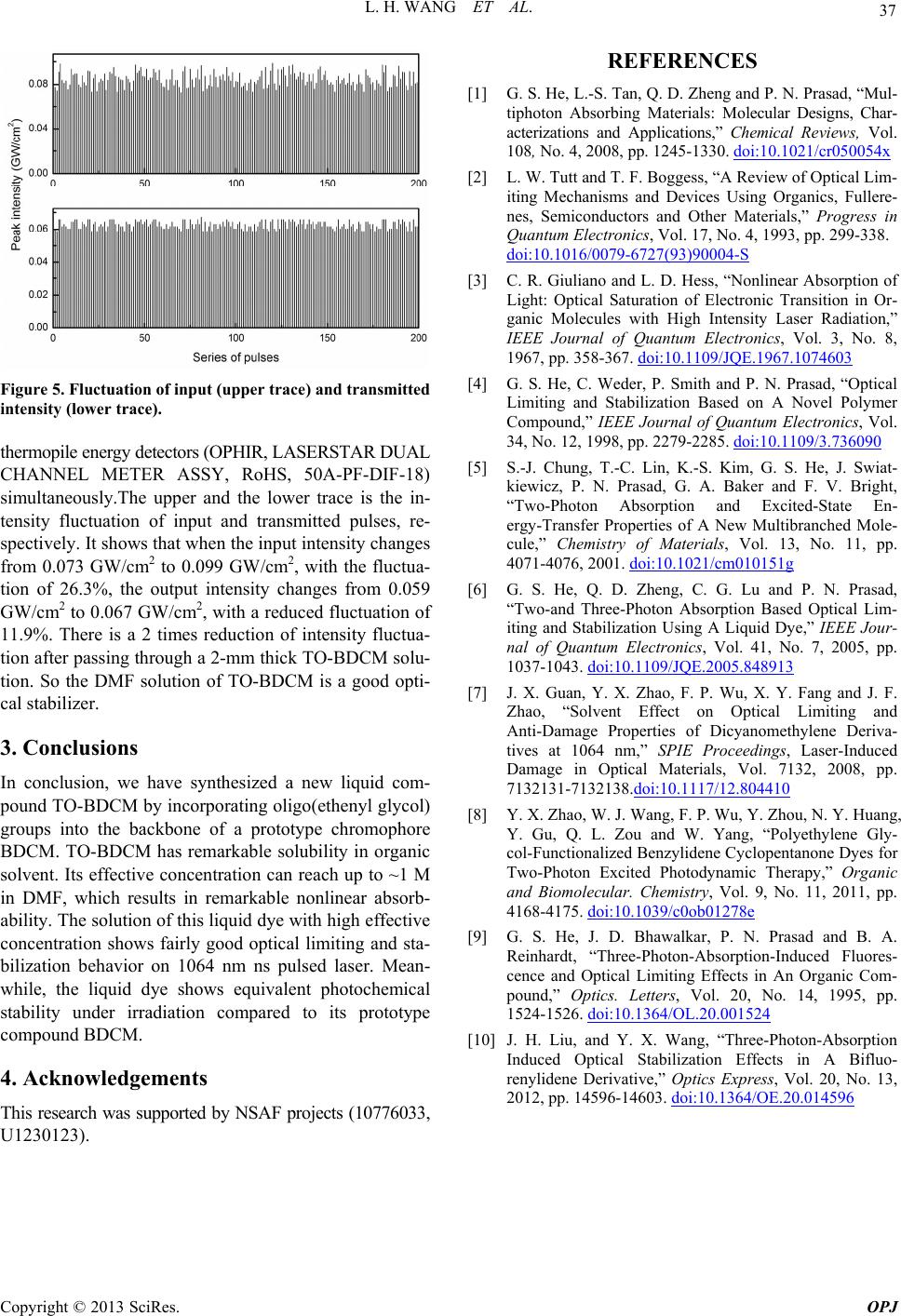
L. H. WANG ET AL.
Copyright © 2013 SciRes. OPJ
37
REFERENCES
[1] G. S. He, L.-S. Tan, Q. D. Zheng and P. N. Prasad, “Mul-
tiphoton Absorbing Materials: Molecular Designs, Char-
acterizations and Applications,” Chemical Reviews, Vol.
108, No. 4, 2008, pp. 1245-1330. doi:10.1021/cr050054x
[2] L. W. Tutt and T. F. Boggess, “A Review of Optical Lim-
iting Mechanisms and Devices Using Organics, Fullere-
nes, Semiconductors and Other Materials,” Progress in
Quantum Electronics, Vol. 17, No. 4, 1993, pp. 299-338.
doi:10.1016/0079-6727(93)90004-S
[3] C. R. Giuliano and L. D. Hess, “Nonlinear Absorption of
Light: Optical Saturation of Electronic Transition in Or-
ganic Molecules with High Intensity Laser Radiation,”
IEEE Journal of Quantum Electronics, Vol. 3, No. 8,
1967, pp. 358-367. doi:10.1109/JQE.1967.1074603
[4] G. S. He, C. Weder, P. Smith and P. N. Prasad, “Optical
Limiting and Stabilization Based on A Novel Polymer
Compound,” IEEE Journal of Quantum Electronics, Vol.
34, No. 12, 1998, pp. 2279-2285. doi:10.1109/3.736090
Figure 5. Fl uctuation of input (upper trace) and tr ansmitte d
intensity (lower trace).
thermopile energy detectors (OPHIR, LASERSTAR DUAL
CHANNEL METER ASSY, RoHS, 50A-PF-DIF-18)
simultaneously.The upper and the lower trace is the in-
tensity fluctuation of input and transmitted pulses, re-
spectively. It shows that when the input intensity changes
from 0.073 GW/cm2 to 0.099 GW/cm2, with the fluctua-
tion of 26.3%, the output intensity changes from 0.059
GW/cm2 to 0.067 GW/cm2, with a reduced fluctuation of
11.9%. There is a 2 times reduction of intensity fluctua-
tion after passing through a 2-mm thick TO-BDCM solu-
tion. So the DMF solution of TO-BDCM is a good opti-
cal stabilizer.
[5] S.-J. Chung, T.-C. Lin, K.-S. Kim, G. S. He, J. Swiat-
kiewicz, P. N. Prasad, G. A. Baker and F. V. Bright,
“Two-Photon Absorption and Excited-State En-
ergy-Transfer Properties of A New Multibranched Mole-
cule,” Chemistry of Materials, Vol. 13, No. 11, pp.
4071-4076, 2001. doi:10.1021/cm010151g
[6] G. S. He, Q. D. Zheng, C. G. Lu and P. N. Prasad,
“Two-and Three-Photon Absorption Based Optical Lim-
iting and Stabilization Using A Liquid Dye,” IEEE Jour-
nal of Quantum Electronics, Vol. 41, No. 7, 2005, pp.
1037-1043. doi:10.1109/JQE.2005.848913
[7] J. X. Guan, Y. X. Zhao, F. P. Wu, X. Y. Fang and J. F.
Zhao, “Solvent Effect on Optical Limiting and
Anti-Damage Properties of Dicyanomethylene Deriva-
tives at 1064 nm,” SPIE Proceedings, Laser-Induced
Damage in Optical Materials, Vol. 7132, 2008, pp.
7132131-7132138.doi:10.1117/12.804410
3. Conclusions
In conclusion, we have synthesized a new liquid com-
pound TO-BDCM by incorporating oligo(ethenyl glycol)
groups into the backbone of a prototype chromophore
BDCM. TO-BDCM has remarkable solubility in organic
solvent. Its effective concentration can reach up to ~1 M
in DMF, which results in remarkable nonlinear absorb-
ability. The solution of this liquid dye with high effective
concentration shows fairly good optical limiting and sta-
bilization behavior on 1064 nm ns pulsed laser. Mean-
while, the liquid dye shows equivalent photochemical
stability under irradiation compared to its prototype
compound BDCM.
[8] Y. X. Zhao, W. J. Wang, F. P. Wu, Y. Zhou, N. Y. Huang,
Y. Gu, Q. L. Zou and W. Yang, “Polyethylene Gly-
col-Functionalized Benzylidene Cyclopentanone Dyes for
Two-Photon Excited Photodynamic Therapy,” Organic
and Biomolecular. Chemistry, Vol. 9, No. 11, 2011, pp.
4168-4175. doi:10.1039/c0ob01278e
[9] G. S. He, J. D. Bhawalkar, P. N. Prasad and B. A.
Reinhardt, “Three-Photon-Absorption-Induced Fluores-
cence and Optical Limiting Effects in An Organic Com-
pound,” Optics. Letters, Vol. 20, No. 14, 1995, pp.
1524-1526. doi:10.1364/OL.20.001524
[10] J. H. Liu, and Y. X. Wang, “Three-Photon-Absorption
Induced Optical Stabilization Effects in A Bifluo-
renylidene Derivative,” Optics Express, Vol. 20, No. 13,
2012, pp. 14596-14603. doi:10.1364/OE.20.014596
4. Acknowledgements
This research was supported by NSAF projects (10776033,
U1230123).